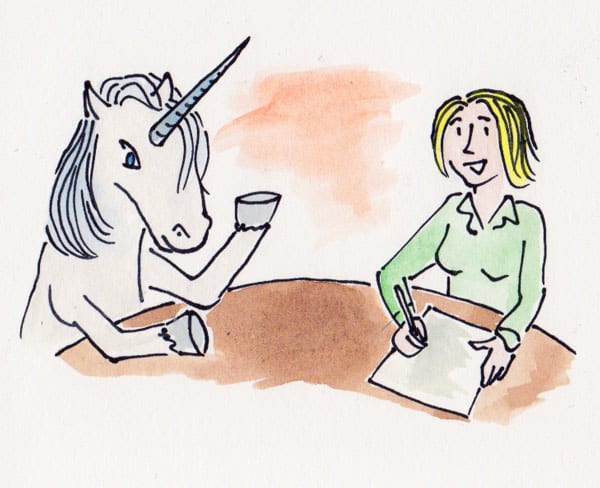Georgie Carpenter is the founder of 10collective—a recruiting agency specialising in IT and UX roles. Matt interviewed her a while back as research for our book Get Started in UX, the complete guide to launching and growing a career in user experience design. Read on to hear Georgie’s insider tips about getting a competitive advantage in your hunt for the ideal UX job.
Can you tell us about 10collective?

10collective was a company that I started by accident in 2008. I walked out the door of my previous company, an IT recruitment agency, and received a call from a client who said, “Can you find me a developer”? I said, “Okay” and on autopilot I found one and made a placement.
At the time, it was just a bit of fun and I assumed I would spend my newfound free-time painting or writing books, but it snowballed from there. In the end, I needed to hire an additional employee, and soon after that we moved into an office in Fitzroy.
At that point I’d been recruiting user experience people for a number of years. There is some debate about whether the position should even be called “User Experience” anymore, because it’s really “experience design” to some of the more established UXers.
You’ve been recruiting UX professionals for quite a while. What changes have you seen in the industry since 10collective started?
Clients certainly want UX professionals more now than they did years ago. Employers understand that UX is important and that consumers want a better “user experience” for their public-facing website.
I’m not convinced that all employers actually understand what user experience means yet, although it’s definitely more prevalent. The first school of UXers that I worked with sought to evangelise UX as important and essential, but now it is less of a fight. There is still some education to be done around what a UXer actually does, but the term “user experience” has changed, or evolved, quite substantially. If you were to ask some job hunters or employers, the difference between “user experience” and “usability”, they can’t always tell you.
Nowadays, different types of organisations want UXers, not just organisations with immense budgets. Employers don’t necessarily want what I was looking for years ago—hardcore UXers that understand interaction design and contextual enquiry—they just want a UXer to use their common sense, which is not entirely unreasonable.
The first school of UXers were very much user and research-centric. That isn’t something that a lot of my clients can even do given their budget limitations. UXers are now being sought for their established expertise rather than what they can discover by research. Many user experience people still want to be involved with the user, though. It is frustrating that many organisations are offering user experience services and user experience expertise, but they don’t have much exposure to the actual user.
Are those who are getting into user experience coming from a visual background? Is that the general path?
Yes—if you have a visual background and a good foundation of the basic principles of user experience and usability, then that’s an effective avenue for you to get a job with the title, “User Experience Designer”. Whether you can truly be a UX Designer at that point is debatable.
Do you think that you’re on the back foot if you’re not coming from a visual design background?
I think so, yes. Many agencies, for example, don’t need just “researchers” anymore— they do require you to have visual design skills as well. You need to be able to get a piece of paper and a pen and throw together some sketches. You would need to have a basic understanding of user experience or usability in order to satisfy the job briefs that we’re getting from clients, on the whole.
What skillsets are clients looking for in UX roles? Does the client say they need a user experience person when what they really want is a visual designer who’s going to use their brain?
Commonly, a client such as a digital or advertising agency will want someone in-house who is a visual designer with agency experience, but who also understands the principles of user experience. What that means is they need someone to do wireframing and prototyping, interview stakeholders and users and be able to expertly review the application or site.
There isn’t a decent understanding of the need for the individual to lead focus groups or use eye-tracking equipment or do card sorting. In many cases, it’s unlikely that those activities are going to happen in a small to medium agency, unless their clients agree to pay a reasonable amount of money. The Account Services team also needs to be able to sell those services—which is another debate entirely!
Skills-wise, a UXer would ideally have experience with Axure and Balsamiq, have some exposure to Visio and be able to use the Adobe Creative suite. UXers need to be able to defend their designs and engage in conceptualisation and ideation. Importantly, they need to have worked on robust and meaty applications. They also need to know how to talk to people, obviously!

Nowadays, are UXers being employed in-house or as contractors?
A lot of people are doing contract work at the moment because they get better money contracting. Freelance projects are common. If you are a career UXer, you will probably end up contracting to say, three to five extremely loyal clients that use you repeatedly and pay you excellent money. Essentially, in recruiting we have had many top UXers wiped from the market which is a tragedy for smaller businesses who really could use the expertise of those people.
I advise UXers to do contract work as much as they possibly can now, but start looking for a permanent or good long-term contract within the next six to twelve months. Recruiting is a good option to help with that.
How do you determine whether an applicant truly understands what UX is?
When recruiting, I start by asking the applicant a basic and disarming question, “What is User Experience?” Oftentimes they just tell me what usability is and I might prod them until I get a better answer. Having a robust opinion about the field you engage in is compelling in job interviews. I know that UXers have to be pragmatic and maybe educate users, but users are supposed to inform your design. It’s a fairly good sign when I hear that a UXer is not attempting to change the user. Many applicants don’t even mention the user and that’s a black mark most of the time. User experience is not just the experience the user has with your product.
Would you say having a process and being able to talk about it is important?
I think so. I love it when I ask an applicant to take me through their process and the first thing they do is grab a piece of paper and a pen and take me through their process with some decent narrative.
Storytelling is a critical component of UX on the job, so I like to see evidence of that in a recruiting interview. A candidate must also have experience with the activities and practises that fall under the user experience umbrella.
What advice would you give a candidate coming into UX from another area, such as business analysis, creative production or development?
I’d advise against calling yourself a user experience designer if you’re not comfortable doing so—simply say you’re a producer with UX skills or a project manager with UX skills, or focus on the research side of things if that is how you are inclined.
The word “designer” is misleading to many companies. If a company is hiring, an applicant’s first gateway is an HR person who usually doesn’t know what user experience designers do. They see the word “designer” and they imagine someone creative for the job. You actually don’t need to be particularly creative to be a fabulous user experience researcher, in the traditional sense, although the UX discipline firmly belongs in the creative sphere.
I would advise job seekers to get into their UX community. Start reading some old school HCI usability UX blogs—for example Jakob Nielsen—but also get into some new blogs. Attend a UX Book Club and network. Simply being around UX people will give you some context around what you do and how that’s relevant to the user experience process. Doing so also gives you an idea of the language inside the UX and Design world—using relevant terminology is always useful in an interview!
Take a Business Analyst for example. What a Business Analyst does is so relevant to UX—how they interview and observe people, create specifications and evaluate scenarios. The thought process they go through is key for a UXer, but a Business Analyst needs to know how to describe what they do in UX terms.

How should a candidate prepare for an interview if they get to that stage? Would you recommend a portfolio for someone who doesn’t have a substantial visual background?
Absolutely. A user experience folio is not a design folio—it’s a case study folio and a dissection of all the activities it took to get to whatever outcome you’ve reached. What I recommend with UX folios is that once you’ve determined that a particular activity pertains to the UX discipline, you need to dissect it.
An infographic or something visual is a good idea to illustrate what you’ve done. It doesn’t need to be a band poster; it needs to be something like a screenshot of your wireframe or an infographic to show how you got to the end result.
Opinions don’t hurt, either. For example, saying, “These are the results—they were surprising for such and such reason” is pertinent for both user experience professionals and those who want to get into user experience. Giving your opinion demonstrates that you understand that those analytical skills are transferable to the discipline.
Having a folio to kick-off the discussion can be a difficult concept for many job seekers. Some UXers I know, who are absolutely amazing, have never landed a job with a folio or a CV because everyone knows their reputation so they get jobs via word of mouth. However, I still think that they should have a beautiful folio—a dissection of their ideas, their opinions and their assumptions and then how they’ve backed those things up with actual data, research and design expertise.

Do you have some general tips on how to make the most out of an interview?
Firstly, when running through your work history, ensure that your timeline actually makes sense. If you’ve been fired a bunch of times, you just need to come clean and admit it before it comes out later in the recruiting process.
Most interviews will have a behavioural interview component. The philosophy behind behavioural interviewing is that how you have acted in certain situations in the past can predict how you would act in similar situations in the future. I think it’s a flawed philosophy as nothing can predict any of those things, but behavioural interviewing during recruiting is generally believed to give an indication.
I think job seekers need to learn how to handle behavioural interviews. Most questions in this format start with, “Describe a time when…”. You need to think of a specific example in your past where you addressed the question and answer along the STAR format.
You should then analyse what you did wrong in the example you chose and also what you learned from it. If you can apply that way of answering to every behavioural question you are asked, you’re laughing.
It’s OK to use a personal scenario if you can’t apply the question to a work one. If you are changing fields, all people need to know is that you can learn and adapt to the new position that you’re applying for.
That’s where behavioral interviewing can be very useful during the recruiting process. It assesses your aptitude, emotional intelligence, commercial maturity, self-awareness and your ability to learn. If you have the skillset that is required but cannot demonstrate the key competencies in the role via a behavioural interview, then a client is unlikely to hire you.
The other piece of advice I would give is to practice your ability to decide which questions require a long answer and which ones require a short answer. It is fairly essential not to bore the interviewer.
There is some debate about how long your CV should be. What are your thoughts on that?
It depends on the client. Some clients need to be educated around what your experience is, in which case a four or five page CV can be helpful for them. There are also clients that are savvy enough to read between the lines and can draw what they need in a one to two pager. Your CV shouldn’t go any longer than four or five pages.
Your CV needs to compel a client to read on within the first five seconds of looking at it. If it does, they’ll spend the time to read the rest. If it doesn’t, it makes no difference whether your CV was one, four or thirty pages—it won’t get read.
Some of the most talented people I know don’t have good CVs. They have one page that says, “I’ve done this”. That’s good enough for them because they know people, but it’s not good enough for all of my clients.
For UXers, when you write your CV, you need to be prepared to answer the question, “How do you use your understanding of the UX discipline in the design of your CV?” Many people in the UX field do not use their skills in designing this very important piece of paper.
Your expertise has a Melbourne bent. Do you have a sense for whether there are hotspots for UX in the rest of the country, or globally?
I have many English and American people approach me for roles in Australia. Their understanding of user experience, and how it’s used practically, is quite different to ours. Recruiting for UX looks different in different places. One of the criticisms I commonly hear, from British people especially, is that nothing gets done in UX in Australia—we spend too much time in concept, too much time in research and not enough time doing.
The other piece of positive feedback that I get is that Australians are very detail oriented and we do get UX right. When I went to London last year, a mobile director for a very large and well-known digital agency remarked that Australia’s user experience for mobile applications was second to none. I’ve also heard—and I don’t know if this is true—that there is an amazing user experience scene in South America. I’ve not done any recruitment there, but I have had some people with South American roots come to me.
Considering there is a demand for UX, is it fair to say a UXer can be choosy about which jobs they take and what they do on them?
Yes and no. There was definitely a time I was getting frustrated at the UX community for being princesses during recruiting in all kinds of areas— wage, working hours, the stage of UX and design maturity—but the community is coming out of that now. Frankly, as any kind of job seeker, you should be picky about your job choice.
I think work cultures are very institutionalised in some organisations. Even though the organisation is saying they need a UX person, in fact, there may not be a place for them there culturally.
If you have to evangelise and educate, it’s a 24/7 job. It’s a very rare person who could do the job part-time. You have to be constantly showing the client that you are not only good at your job but that you are actually adding value. The issue is that what you provide isn’t necessarily something you can hold in your hand and show someone.
When you’re not proving to the client that you’re adding value, you’re being an entrepreneur, validating tests or doing experiments. Do you think the client values that learning?
Not always—and that’s a fairly dangerous position to be in during recruiting if there’s a recession imminent. Ultimately, if you’re not providing tangible deliverables and a return on investment right here and now, you might get relegated to middle management status, and I think we can all agree that middle management people always go first in the lay off rounds.
Is there a seasonal demand for UX work?
UX work is seasonal, absolutely. UXers are always involved during production, even though they should probably by around before the idea even happens. January is not a great time to go through the recruiting process to find a UX job compared to the rest of the year, but then January is not a good time to find a job for anybody!
You can read more about UX recruiting, and how to use it to your advantage as a UXer looking for work, in our ebook Get Started in UX.





